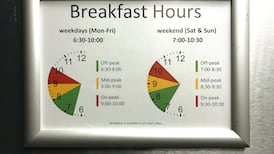There seems to be a general acceptance, behind the scenes at least, in Government that the game is up when it comes to the targets set in Housing for All, the national housing strategy. Ministers may not yet be ready to admit publicly that its flagship policy is a dead duck, but the ground is being softened for an eventual concession that the targets will need to be substantially revised.
There have been off the record briefings to the effect that the Minister for Finance has been told that the current target of 33,000 new homes per year per year will have to be upped to something like 50,000.
However, it looks as if it will be left to the Economic and Social Research Institute (ESRI) – the Government-funded but independent economic think tank – to deliver the coupe de grace to the current targets.
At the heart of the problem is the 2022 Census data. The current targets are based on published population projections from the Central Statistics Office (CSO) drawn from the 2016 census. They predict that the population will reach 5.7 million people in 2041 based on conservative estimates about migration and fertility – the number of children that people already living here will have. The CSO has no immediate plan to plan to publish updated projections based on the 2022 census. No doubt it will do so once it is satisfied with the accuracy of its figures.
READ MORE
So, in theory, the current housing targets are valid, even if they are far from credible, because they are based on the latest official data. It’s a bit like the annual tractor manufacturing targets in the former Soviet Union.
... ESRI analysis of preliminary 2022 census data indicate that the population will hit 5.7 million at the end of the decade, a full 10 years earlier than the predicted date used in the calculation underlying the current housing targets
Unfortunately – or fortunately depending on your point of view – the ESRI has started to use the preliminary data from the 2022 census for its work and has come up with its own projections for population growth.
[ Government finally admits housing targets ‘significantly below’ demandOpens in new window ]
An inkling of what is to come was contained in a report on the National Development Plan done by the ESRI for the Department of Public Expenditure and published in January. In the section on future demand for housing it pointed out: “While it is not possible to quantify the potential changes at this stage, it is very likely, given the preliminary data from the census, that the revised estimates of structural demand will be somewhat larger than the existing ones.”
The big reveal will most likely come next month when the revised estimates for housing demand mentioned above are delivered to the Department of Housing. The new figures will be based on the ESRI analysis of preliminary 2022 census data, which indicate that the population will hit 5.7 million at the end of the decade, a full 10 years earlier than the predicted date used in the calculation underlying the current housing targets. The cat will be officially out of the bag.
The department has delayed the publication of the National Planning Framework (NPF) in anticipation of the ESRI report. This is only sensible as the NPF is meant to guide high-level strategic planning over the next 20 years taking into account population growth. It will now be published in June.
Returning to the theme of Stalinist-era tractor manufacturing in the USSR, you can promise the peasants more tractors but if you can’t deliver them the peasants will eventually revolt
It is not clear at this stage how much longer the Government plans to continue with the fiction that its current housing targets are meaningful. Ministers seem to be hedging their bets. The Taoiseach announced earlier this week that the number of new houses delivered this year is likely to be closer to 40,000 homes than 30,000. “It will be on the upper end rather than the lower end of that range,” he said. It might have been a bit more accurate to say that they will fall 10,000 homes short of the number needed based on the latest census data.
Eventually the Government will have to confront this reality, which ministers are currently choosing to squint at through their fingers. Their reluctance is understandable. They have exhausted all the “easy” options when it comes to stimulating house building and something radical will be required or there will be trouble. Returning to the theme of Stalinist-era tractor manufacturing in the USSR, you can promise the peasants more tractors but if you can’t deliver them the peasants will eventually revolt.
[ Ramping up home building isn't impossible – we've done it beforeOpens in new window ]
And housing is not the only headache caused by the 2022 census data. The denouement will come at the end of the summer when the ESRI is due to publish a review of the National Development Plan. It will presumably factor in the impact of much faster than expected population growth on demand in areas such as transport, education and health.
The Government faces the prospect of going into the next election with its plans holed below the waterline by the ESRI. Ministers must be tempted to hide behind the sofa at this stage, given the horror movie unfolding in front of their eyes.












